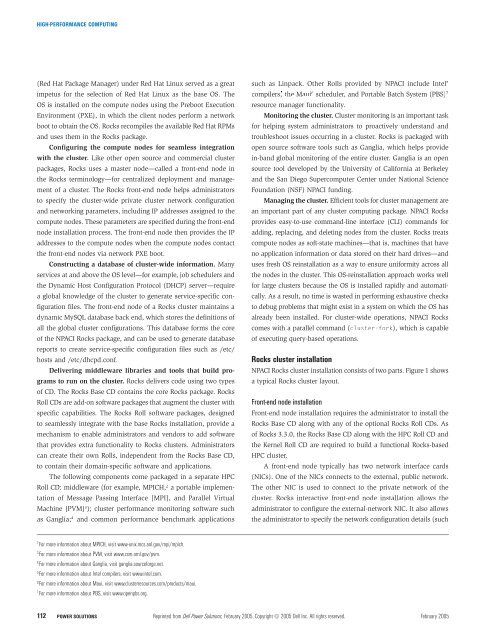Dell Power Solutions
Dell Power Solutions
Dell Power Solutions
- No tags were found...
Create successful ePaper yourself
Turn your PDF publications into a flip-book with our unique Google optimized e-Paper software.
HIGH-PERFORMANCE COMPUTING(Red Hat Package Manager) under Red Hat Linux served as a greatimpetus for the selection of Red Hat Linux as the base OS. TheOS is installed on the compute nodes using the Preboot ExecutionEnvironment (PXE), in which the client nodes perform a networkboot to obtain the OS. Rocks recompiles the available Red Hat RPMsand uses them in the Rocks package.Configuring the compute nodes for seamless integrationwith the cluster. Like other open source and commercial clusterpackages, Rocks uses a master node—called a front-end node inthe Rocks terminology—for centralized deployment and managementof a cluster. The Rocks front-end node helps administratorsto specify the cluster-wide private cluster network configurationand networking parameters, including IP addresses assigned to thecompute nodes. These parameters are specified during the front-endnode installation process. The front-end node then provides the IPaddresses to the compute nodes when the compute nodes contactthe front-end nodes via network PXE boot.Constructing a database of cluster-wide information. Manyservices at and above the OS level—for example, job schedulers andthe Dynamic Host Configuration Protocol (DHCP) server—requirea global knowledge of the cluster to generate service-specific configurationfiles. The front-end node of a Rocks cluster maintains adynamic MySQL database back end, which stores the definitions ofall the global cluster configurations. This database forms the coreof the NPACI Rocks package, and can be used to generate databasereports to create service-specific configuration files such as /etc/hosts and /etc/dhcpd.conf.Delivering middleware libraries and tools that build programsto run on the cluster. Rocks delivers code using two typesof CD. The Rocks Base CD contains the core Rocks package. RocksRoll CDs are add-on software packages that augment the cluster withspecific capabilities. The Rocks Roll software packages, designedto seamlessly integrate with the base Rocks installation, provide amechanism to enable administrators and vendors to add softwarethat provides extra functionality to Rocks clusters. Administratorscan create their own Rolls, independent from the Rocks Base CD,to contain their domain-specific software and applications.The following components come packaged in a separate HPCRoll CD: middleware (for example, MPICH, 2 a portable implementationof Message Passing Interface [MPI], and Parallel VirtualMachine [PVM] 3 ); cluster performance monitoring software suchas Ganglia; 4 and common performance benchmark applicationssuch as Linpack. Other Rolls provided by NPACI include Intel ®compilers, 5 the Maui 6 scheduler, and Portable Batch System (PBS) 7resource manager functionality.Monitoring the cluster. Cluster monitoring is an important taskfor helping system administrators to proactively understand andtroubleshoot issues occurring in a cluster. Rocks is packaged withopen source software tools such as Ganglia, which helps providein-band global monitoring of the entire cluster. Ganglia is an opensource tool developed by the University of California at Berkeleyand the San Diego Supercomputer Center under National ScienceFoundation (NSF) NPACI funding.Managing the cluster. Efficient tools for cluster management arean important part of any cluster computing package. NPACI Rocksprovides easy-to-use command-line interface (CLI) commands foradding, replacing, and deleting nodes from the cluster. Rocks treatscompute nodes as soft-state machines—that is, machines that haveno application information or data stored on their hard drives—anduses fresh OS reinstallation as a way to ensure uniformity across allthe nodes in the cluster. This OS-reinstallation approach works wellfor large clusters because the OS is installed rapidly and automatically.As a result, no time is wasted in performing exhaustive checksto debug problems that might exist in a system on which the OS hasalready been installed. For cluster-wide operations, NPACI Rockscomes with a parallel command (cluster-fork), which is capableof executing query-based operations.Rocks cluster installationNPACI Rocks cluster installation consists of two parts. Figure 1 showsa typical Rocks cluster layout.Front-end node installationFront-end node installation requires the administrator to install theRocks Base CD along with any of the optional Rocks Roll CDs. Asof Rocks 3.3.0, the Rocks Base CD along with the HPC Roll CD andthe Kernel Roll CD are required to build a functional Rocks-basedHPC cluster.A front-end node typically has two network interface cards(NICs). One of the NICs connects to the external, public network.The other NIC is used to connect to the private network of thecluster. Rocks interactive front-end node installation allows theadministrator to configure the external-network NIC. It also allowsthe administrator to specify the network configuration details (such2For more information about MPICH, visit www-unix.mcs.anl.gov/mpi/mpich.3For more information about PVM, visit www.csm.ornl.gov/pvm.4For more information about Ganglia, visit ganglia.sourceforge.net.5For more information about Intel compilers, visit www.intel.com.6For more information about Maui, visit www.clusterresources.com/products/maui.7For more information about PBS, visit www.openpbs.org.112POWER SOLUTIONS Reprinted from <strong>Dell</strong> <strong>Power</strong> <strong>Solutions</strong>, February 2005. Copyright © 2005 <strong>Dell</strong> Inc. All rights reserved. February 2005








